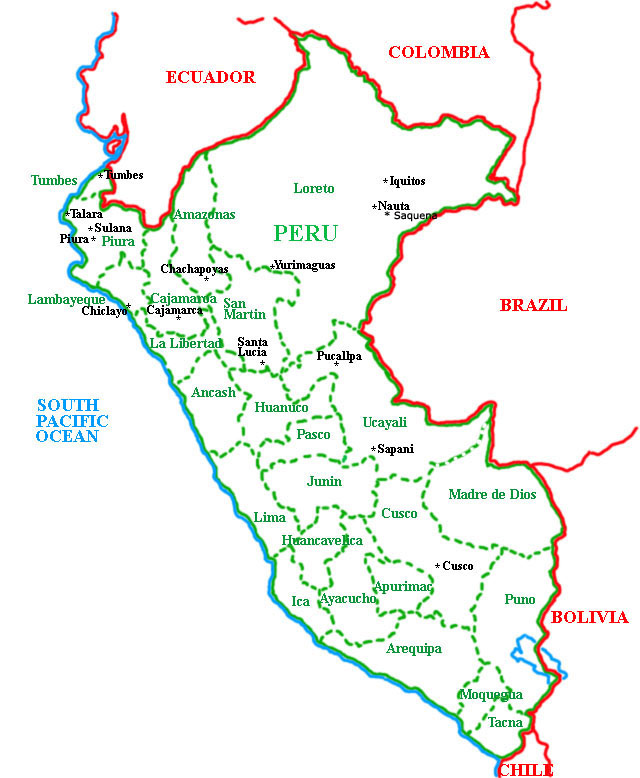Manduca: white apical patch on forewing; two rows of white dots on abdomen, white on juncture of thorax and abdomen; three yellow-orange marks on each
side of abdomen
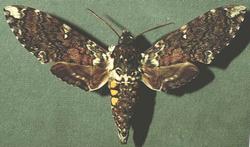
Manduca dalica dalica; 120-135mm:
Fw: dark, purplish-brown in median & subterminal areas.
Thin, black, very irregular aml inwardly traced in white, additional white along forewing base
& across thorax/abdomen juncture. Thin white line across head behind eyes.
Discal spot: large, white, connected by white triangular patch to suffusion on costal margin.
Whitish-grey apical patch, &
small, whitish mark anterior of anal angle. Space between 2nd & 3rd discal lines dark grey.
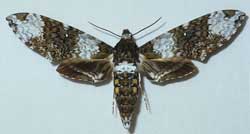
Manduca albiplaga:
Large white apical patch in upper half of postmedian area from outside of pm line to apex; another large white patch
from costa to inner margin just outside the basal area. Two white areas not contiuous as in rustica.
|
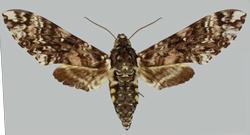
Manduca leucospila ; FWl: 47mm:
Space along i.m. between aml & post-discal lines: pale, suffused with buff.
Large greyish-white patches anterior to oblique apical line, and in submarginal area.
Smaller white patch & submarginal zigzag line near anal angle. Black streak connects 3rd antemedian & 1st discal
lines between veins CuA1 and CuA2; discal lines sharply dentate, 2nd and 3rd close together, with the space between spotted with white,
the lines more evenly curved than in Manduca rustica; fringe with white spots large, extending onto the wing membrane.
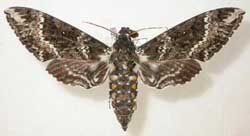
Manduca camposi :
Very prominent, continuous, jagged, white band from costa to inner margin, obtusely angled near its midpoint, between second and third
postmedian lines.
Cell spot tiny, white without any connection to dark costa. Am line bordered in white.
|
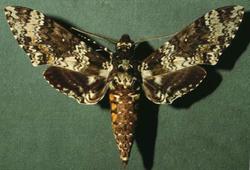
Manduca rustica
Broad, dominant U-shaped whitish area from costa (just outside am line) to inner margin; along inner margin
to last pm line and inside that line to first pm line to costa. Median area bounded by this shape is grey-brown with white cell and no
white triangle joining cell to costa. Lower inside 1/4 of basal area white with white marks above. Much white in terminal area.
Note inverted white v's, like eyebrows, over dark triangles on mid thorax. Strong white presence at juncture of thorax/abdomen.
|
Manduca: Slaty grey area between inner and outer pm lines; upper half of outer pm line concave;
inner pm line obtusely angled near its midpoint; subterminal line black, thick near anal angle; five or six
large yellow-orange marks on each side of abdomen.
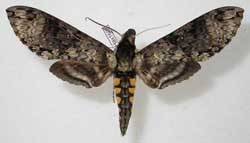
Manduca clarki:
Similar to but smaller than M. lucetius, with pale parts of
thorax and wings grey, without a yellowish buff tint as in lucetius.
Abdomen upperside with white dorsal spots vestigial or diffuse; 7th segment without yellow lateral patch.
Fore- and hindwing pattern almost identical to those of Manduca lucetius, except that the marginal grey band of the hindwing less shaded with black,
but more so than in Manduca scutata or Manduca pellenia.
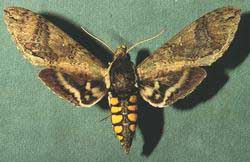
Manduca hannibal :
Ground colour different shades of brown with generous suffusions of tiny charcoal grey scales, creeating a somewhat grainy appearance.
Lighter colouration (creamy buff) without suffusion along inner margin, anal angle and outer margin. Am and pm lines less convergent
below cell than in upper three species. Very weak subterminal line
|
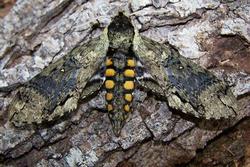
Manduca lucetius:
Slaty black downy patches very pronounced,
forming, together with a patch in the discal cell, a large semicircle filled with black scaling, this contrasting strongly with the paler, russet basal and
distal areas; discal and postdiscal lines less curved than in Manduca diffissa petuniae near vein M3, but more so than in Manduca sexta; white dots of the
fringe sometimes encroaching on the wing, being slightly enlarged basad, though they may be very small or absent.
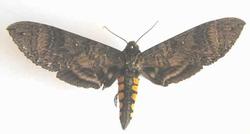
Manduca diffissa tropicalis :
Grey brown, often darker in cell region. Terminal line tends to be more pronounced, with small rectangular like projections, than in other species in this group.
|
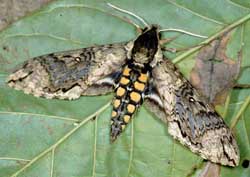
Manduca pellenia:
Antenna: stout as in Manduca sexta.
Abdomen underside shaded with brown scales, especially in the male.
Forewing upperside with discal, black, pubescent patches heavy, forming a band that is strongly angled near vein M3; the oblique, black apical line and the
posterior part of the black postdiscal line both very heavy; submarginal zigzag line creamy buff rather than white; the cells between veins M3 and CuP more or
less russet between the discal band and postdiscal line.
|
|
Manduca
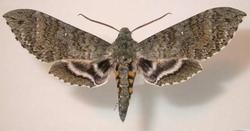
Manduca mossi
:
Greyish lines: diffuse, not in sharp contrast with grainy grey (basal, median, terminal areas)
and grey-brown (inner lining of aml and postmedian areas). Cell spot: small, thick v-shape with apex toward
head. Apical area concolorous with terminal area. Inner pm line concave 40%, right angle, then again concave for lower
60%.
|
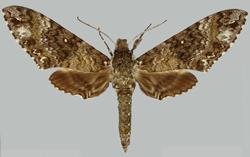
Manduca trimacula:
Body & forewing brownish-yellow, mottled with grey and tawny olive.
Abdomen: two rows of abdominal white dots; segments 1-3 with a yellow lateral patch bordered with black.
Undulate and zigzag lines well-marked; discal and postdiscal lines curved as in Manduca sexta, the space between the 2nd and 3rd discal
lines white between veins Rs3 and Rs4, greyish white elsewhere; also greyish white on the distal side of the 3rd discal line; the space between the heavily-marked
1st and 2nd discal lines scarcely darker than the rest of the disc, not silky black as in Manduca lucetius; postdiscal line heavy, forming a patch on vein M3 and
behind CuA2, followed by a large, ill-defined, creamy white patch at vein M2 in post median area;
discal spot nearly white, round; oblique apical line heavy, with a creamy white border anteriorly
|
|
Manduca: Outer postmedian line in smooth S-shape on left forewing
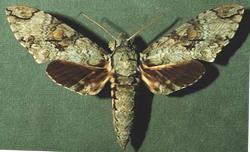
Manduca florestan
Fw gray to yellowish gray to brown with greenish tint in fresh specimens. Two black dashes running from below cell toward outer margin. Prominent reddish brown patch
outside cell, above dashes. Left fw pm lines: S-shaped, prominent for upper 3/4. Body side of black apical, trapezoid, oblique.
|
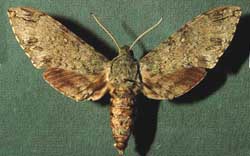
Manduca lanuginosa :
No yellow spots on the sides of the abdomen, gray shoulders, diffuse gray-brown "patternless" wing color, varying from quite dark brown to quite light gray.
Duller, with more uniform colouration than Manduca florestan. The side spots on the abdomen contain less black than in Manduca florestan.
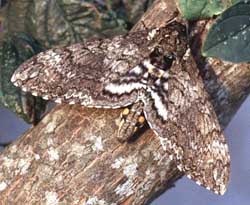
Manduca sexta sexta check distribution
|
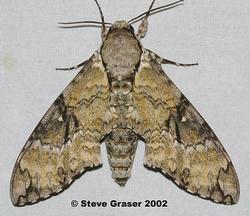
Manduca vestalis :
There is only one prominent, thin but distinct, S-shaped, post median line on the left forewing. The other "pmlines" are broadly diffuse.
Ground colour is light grey, often with a yellowish cast. There are two dark dashes below the cell and the upper half of the median area
is darker than the lower half.
|
|
+++++++
Use your browser "Back" button to return to the previous page.
This page is brought to you by
Bill Oehlke and the
WLSS. Pages are on space rented from Bizland. If you would like
to become a "Patron of the Sphingidae Site", contact Bill.
Please send sightings/images to Bill. I will do my best to respond to
requests for identification help.
 | 
Show appreciation for this site by clicking on flashing butterfly to the left.
The link will take you to a page with links to many insect sites. |
|
